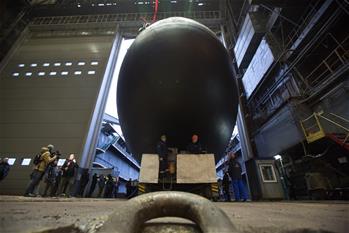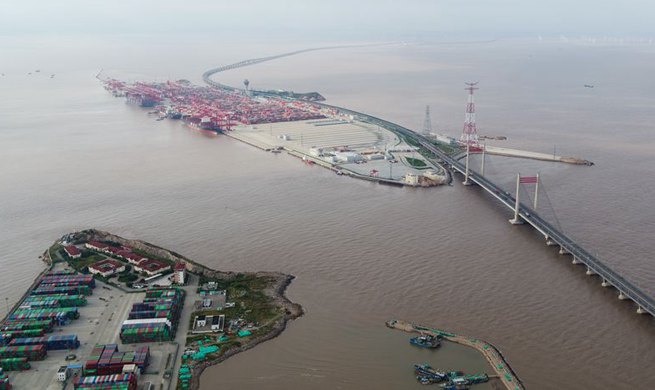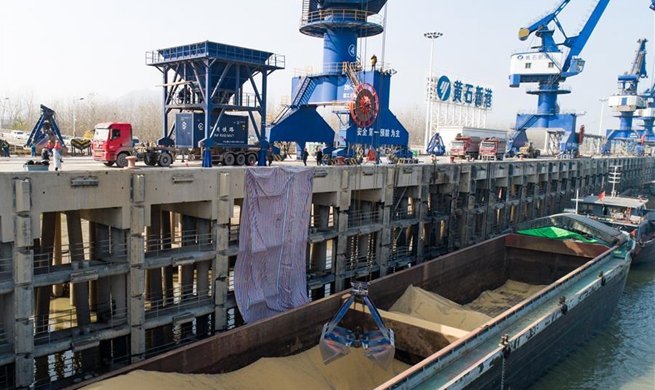ROME, Dec. 27 (Xinhua) -- The inflow of new bad loans in Italy will remain at pre-crisis levels in the next two years, although it would stop decreasing due to an economic slowdown, the Italian Banking Association (ABI) forecast on Friday.
In its new Outlook, provided together with credit rating company Cerved, ABI said levels of non-performing loans (NPLs) to non-financial companies dropped as expected in 2019, reaching 3.1 percent.
"Such result rewards the efforts made by the banking sector in recent years, confirming its overall robustness," ABI Director-General Giovanni Sabatini said in a statement.
For the short-term future, the report predicted a lack of domestic growth would impact negatively on the positive downward trend, "slightly increasing the performing loans deterioration rate up to 3.3 percent in 2021 against 3.1 percent in 2019."
Nonetheless, the loans deterioration rate in this period would remain "below pre-crisis levels (3.6 percent on average between 2006 and 2008)," the report specified.
SUSTAINED DROP IN 2019
Considering data provided by the Bank of Italy, the ABI-Cerved Outlook noted the decreasing trend in the bad loans inflow "has continued at a rapid pace in 2019."
Deterioration rates of non-financial firms showed "a significant contraction both in the first quarter and in the second quarter of 2019, distancing themselves more and more from the negative peaks reached in the economic crisis (7.5 percent by end of 2012)," it explained.
More specifically, the overall loans deterioration rate dropped to 3.1 percent in Q1 and to 2.9 percent in Q2 this year, against 3.3 percent and 3.4 percent in the same periods of 2018, respectively.
Such improvement was registered all across the country, although a significant difference remained between the best performing regions in the northeast (2.3 percent) and the worst performing ones in the south (4.4 percent).
Analyzing the 2019 trend also by sectors, ABI-Cerved highlighted that construction kept improving its stock of NPLs, yet it remained "the most risky sector, and the only one not yet reaching NPLs pre-crisis levels."
However, construction was also the sector in which deterioration rates were decreasing fastest, the report noted, "from 4.7 percent in 2018 to 4.3 percent in 2019, thus confirming a positive trend ongoing since 2014, when it had reached a peak of 11 percent."
On the other hand, manufacturing interrupted a five-year positive decline in 2019, rising to 2.5 percent from 2.4 percent in the previous year, and yet remaining far from the pre-crisis levels (3.3 percent) and the 2012 peak (5.9 percent)."
"The problem of the stock of NPLs in the banks' balance sheets is being solved, after the tough years of (global financial) crisis," Cerved chief executive officer Andrea Mignanelli said.
That the forecast indicated a slight rise in new NPLs was not considered as worrying for the banking sector, he added, because it reflected a stagnation of the Italian economy.
"In such a weak scenario, banks can still recover profit margins by focusing on innovation and digitalization," Mignanelli stressed.
He suggested this strategy would allow banks to boost their loans to small companies -- which constituted the backbone of Italy's economy, the eurozone's third largest -- despite stagnation.
SHORT-TERM FORECAST IN SLOWDOWN SCENARIO
The Outlook predicted that loans deterioration rates of non-financial firms "will slightly increase again" in the next two years, and specifically from 3.1 percent by end of 2019 to 3.3 percent by end of 2021.
This was based on a macroeconomic scenario in which the Italian gross domestic product (GDP) was expected to remain almost flat in 2019, and to grow by less than 1 percent in 2020-2021, ABI and Cerved explained.
"Such rise (in loans deterioration rates) will affect companies of all sizes, all production sectors, and all territorial areas," they wrote.
The Outlook predicted that the inflows of new NPLs among large companies would increase "by five decimal points, stabilizing at 2 percent" by the end of 2021.
Medium and small-sized firms would reach 2.2 percent in the same period, while micro enterprises would "remain the most risky ones, with rates at 3.5 percent."
As for the productive sectors, the report predicted construction would still record the highest percentage of new NPLs at the end of the forecast period (2021), while manufacturing and services would show a more limited rise.
In November, the Bank of Italy said the Italian government's projections of a 0.6 percent GDP growth in 2020 appeared "reasonable" and predicted a 1.0 percent growth at least in 2021.













